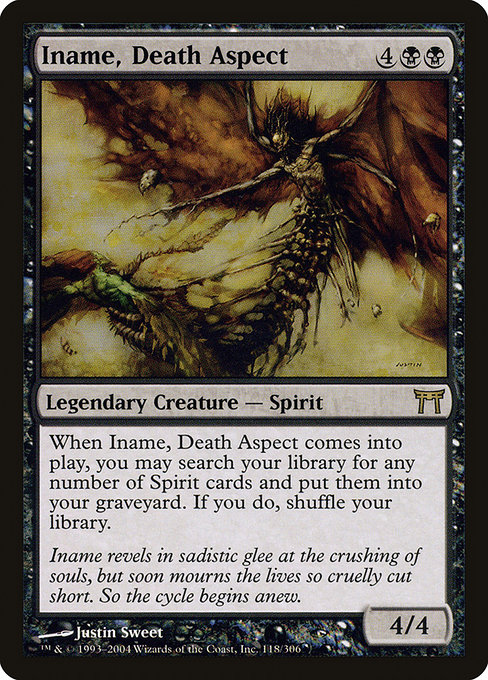
Image courtesy of Scryfall.com
Iname, Death Aspect and the Economics of Sealed Product Scarcity
Sealed product scarcity isn’t just a bragging-right trivia for the oldest boxes crowd; it’s a real lever that twists prices, accessibility, and how players plan their collections. When you combine a card like Iname, Death Aspect with the broader dynamics of limited-run sets and aging product, you begin to see a microcosm of the MTG economy: a dance between supply constraints, speculative demand, and the evergreen allure of powerful—or flavorful—cards. 🧙🔥💎⚔️
Card Snapshot: Iname, Death Aspect
- Name: Iname, Death Aspect
- Set: Champions of Kamigawa (CHK)
- Mana Cost: {4}{B}{B}
- Type: Legendary Creature — Spirit
- Rarity: Rare
- Power/Toughness: 4/4
- Oracle text: When Iname enters, you may search your library for any number of Spirit cards, put them into your graveyard, then shuffle.
- Flavor text: “Iname revels in sadistic glee at the crushing of souls, but soon mourns the lives so cruelly cut short. So the cycle begins anew.”
- Colors: Black
- Print details: From Champions of Kamigawa, rare, foil and nonfoil
- Legalities: Modern, Legacy, Vintage (and more)
Released in 2004, Iname’s six-mana tutu of a body (4/4 for six mana) carries a very intentional graveyard-dense payoff. The ability to tutor out any number of Spirit cards into the graveyard—then shuffle—offers unique upside in Spirit-centric or graveyard-reanimator themes. It’s a strategic message card: if your deck stacks Spirit-name entries, Iname can accelerate your engine by populating the graveyard with a broad cast of ethereal kin. The art by Justin Sweet is a fittingly somber, ceremonial tone for a card that leans into the shadows of Kamigawa’s spirit world. 🎨
Iname isn’t just a one-shot engine; it’s a doorway to a sub-theme that thrives on the psychology of the graveyard. In sealed, these engines come pre-built in your booster stack—if you pull the right supports, you can ride a late-game swing that turns the table in one spell tax. 🧙🔥
Sealed Product Scarcity: Why It Moves the Needle
Scarcity in sealed product is less about the number of cards in a box and more about the lifecycle of the product itself. Early print runs, distribution bottlenecks, and the ebb-and-flow of reprint cycles all shape how boxes, packs, and individual cards trade hands in the market. When a set like Champions of Kamigawa ages, demand for unopened boxes can outpace supply—as can demand for specific rares and foils that define the era’s flavor. In this environment, a card like Iname, Death Aspect—one of the rare, black-leaning power pieces from a beloved block—can become a magnet for collectors who want to anchor a graveyard-centric shell in their deck or simply own a piece of Kamigawa lore. The price signals—roughly around $0.37 for non-foil and significantly higher for foil variants—reflect a balance between playability in modern or eternal formats and the nostalgia-driven premium from collectors. It’s a reminder that the value of sealed product isn’t just about the numbers on a card; it’s about the stories, the box openings, and the memories that gather around a set’s lifecycle. 💎
For investors and players alike, scarcity re-frames risk. A box that’s still widely available in the market might offer a long tail of value as modern decks drift toward more efficient black-hearted control or reanimator shells. Conversely, a box that’s thinning on shelves can push the price of staples—especially legendary creatures with graveyard playlines—upward, even if current formats don’t demand them. The market’s memory is stubborn, and the aroma of nostalgia can lock in premium multipliers for certain prints and foils. 🎲
Mechanics and Limited Play: How Iname Shapes Limited Strategy
In sealed or draft environments, Iname’s effect can catalyze a curve-top scenario. In a Spirit-rich pool, you’re nudged toward a graveyard-focused plan, which might pair nicely with other reanimation or synergy cards from the CHK era. The card’s six-mana investment can be steep in a limited format that rewards faster accelerants, but the payoff—pulling multiple Spirit cards into the graveyard—can snowball into a late-game advantage if your deck already contains or can fetch Spirit lords, recursive combos, or graveyard-reliant finishers. That tension between tempo and value is the hallmark of sealed-era economics: a card that’s not the fastest in your pool can still carry the day if it unlocks a powerful graveyard engine. ⚔️
From an design perspective, Iname captures a period when set design nudged players to consider tribes and synergy across subthemes. The presence of a strong, personal payoff for building around a specific card family often translates to secondary market demand, which interacts with sealed product scarcity. The rarities, borders, and presentation—plus the art—also color the collector’s perspective, influencing whether a box is opened for play or saved as a touchstone of MTG’s evolution. 🧙🔥
Collector Value, Card Design, and Market Realities
Iname’s modern-proof presence in the market—where the card is playable in formats like Modern and Legacy—speaks to a broader truth: cards from older sets can gain a lasting foothold, not just through play but through collectability and curiosity. The foil version fetches a noticeably higher price than the non-foil, a pattern common across CHK and other early 2000s sets. The card’s flavor-rich text and the solemn, arcane vibe of Kamigawa continue to attract players who enjoy the lore as much as the mechanics. And in the context of sealed-product scarcity, owning a pristine Iname can feel like owning a fragment of a storied, turning-point era in MTG design. 🎨
Clear silicone phone case slim flexible protection